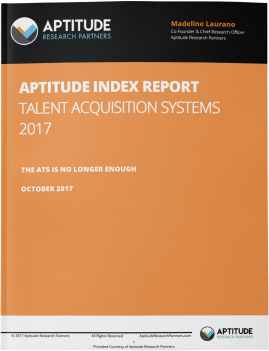The HR Technology Conference is a time to reflect on the past while looking toward the future. More importantly, it gives us a pulse on what matters in the market. And this year, ‘what matters’ feels different. It feels more thoughtful and more meaningful. What matters is less about competing for market share or trying to outshine and outsell our peers. What matters is not how big our booth is or how many times we are on the agenda. This year, what matters is a community coming together to support our Bay Area friends impacted by the Sonoma fires, the importance of women in tech, and the recent tragedy in Las Vegas.
Priorities have shifted. Conversations and discussions moved beyond products and capabilities and focused on the bigger issues. Providers are no longer just talking transforming HR, they are providing solutions and expertise to actually do it. It’s about time. Some of the themes that resonated with us this week included diversity and inclusion, the employee experience, compensation, and enabling better decisions.
Here is my 2017 HR Technology Conference review:
Diversity and Inclusion
In research Aptitude Research Partners conducted earlier this year, diversity and inclusion initiatives were a top three priority for organizations in 2017. This is an area that has been underserved in the past, and today, it seems to be a critical part of most roadmaps. Many of the providers we met with are focused on diversity hiring and offering capabilities such as anonymous screening, job description checkers, and bias detection.
–Talent Sonar: Talent Sonar empowers clients to look at the qualities that predict success. Its 5 Best Hiring Practices support diversity and inclusion efforts by prioritizing job skill sets, creating inclusive job descriptions, enabling a blind resume review, and providing data-driven hiring. Oh, and they just acquired Talent Function with industry rock star, Elaine Orler, joining the team.
–Textio: Textio uses a rich data set based on 300 million job applications and provides “augmented writing” to help recruiters improve job posts and attract a more diverse talent pool. Textio doesn’t currently partner with ATS providers but I am guessing that will change in the future.
–Yello: Yello is no doubt the sleeper of 2017. This provider has raised more money in the past six months than most of its competitors combined (including a $31 Million round of Series C led by JMI Equity). It has an aggressive product roadmap and has made diversity and inclusion a priority through capabilities and specific use cases. It provides companies with insight into their candidate pipeline to see the effectiveness of their diversity and inclusion efforts.
–WCN: Of all the companies I met with last week, WCN was the one that impressed me the most. Partly because I had never heard of them before — and I should have. They support over 400 employers, have a growth rate of over 30%, and cover end-to-end talent acquisition. Their diversity solution strengthens recruitment marketing, events management, and analytics efforts. It also helps companies strengthen their talent pools of diverse candidates actively looking for new jobs.
Experience Economy
According to research by Aptitude, 83% of companies plan to continue to improve the experience of candidates, employees, and managers. But most companies are not clear about where to start. They understand that they should empower individuals, but do not have the right strategies and tools in place. Here are a few providers doing some great work:
–Beamery: Beamery is the company to watch in recruitment marketing this year. Beamery personalizes the candidate experience and allows organizations to measure that experience through every stage of the process and compare data across different functions. It includes feedback surveys, talent promoter scores, and a way to measure recruiter performance.
Jellyvision: Jellyvision combines behavioral science with technology and a little bit of humor to help guide employees through difficult life decisions such as obtaining healthcare coverage, selecting life insurance, and establishing financial wellness. It does this through Alex, a communication platform. The solution is so popular with clients that Jellyvision even tracks the number of marriage proposals that Alex gets each year!
-Jobvite: This provider offers a comprehensive suite of solutions to handle everything from employer branding to attracting talent through onboarding. The entire suite is developed on one code and fully integrated. Analytics and advanced reporting gives clients a full view of the candidate’s entire journey and a consistent experience for users.
–The Muse: The Muse has always been successful at helping individuals prepare for their next job and connect with employers. This year, they are also focusing on employers improve their brand and the overall candidate experience. Johnson & Johnson recently announced its’ Shine initiative- leveraging The Muse to bring a digital and consistent experience to all candidates.
–Survale: Survale is a provider that offers something that every company in every industry needs: an “always-on” tool for collecting feedback and analytics around the candidate experience, quality of hire, and the employee experience. It was founded by former Cytiva executives who understand the importance of measuring the experience and holding recruiters and hiring managers accountable for their performance.
Recruitment Intelligence: Making Better Decisions
AI, machine learning, call it whatever you like…companies are looking for technology providers that can help them make better decisions around how to engage with talent. In fact, Aptitude found that 40% of companies are investing in some type of AI in talent acquisition. HRTech had no shortage of these providers.
–Entelo: Entelo continues to dominate the sourcing market with its latest product, Envoy. Envoy sources on behalf of the customer. It takes care of everything and lets recruiters focus on other initiatives. Customers provide basic information about the job(s) they want to fill and Envoy uses AI to find who would be a good fit and then provides all of the communication to those candidates on behalf of the customer.
–Greenhouse: Greenhouse, with its scorecard functionality and its focus on best practices, is a product that guides recruiters and hiring managers to make the right decisions. It doesn’t force them into the decisions, but it shows them what the obvious answers are and then lets them decide.
–IBM: The power of IBM’s talent acquisition solution can be found in Watson, IBM’s supercomputer that combines artificial intelligence (AI) and sophisticated analytical software for optimal performance as a “question answering” machine. It uses knowledge, skills, and the data within organizations (performance and succession data) to help companies better identify quality hires.
–Symphony Talent: The product differentiates itself because of its simplicity and ease of use. While other ATS solutions are prioritizing the candidate experience, Symphony has invested equally in the recruiter’s experience. It feels more like a consumer product than a corporate talent acquisition solution and AI is built into every stage of the process.
Compensation
Compensation is an interesting market that hasn’t had the attention it deserves, considering it is one of the most important aspects of the employer/employee relationship. Employers are being held more accountable because employees expect more. And so much has changed with the way compensation is managed for organizations. We are seeing an increased emphasis on competitive pay, the need for greater pay transparency, and new regulations around gender pay inequity and executive compensation. These are two providers worth watching in the compensation market:
– Willis Towers Watson: Towers Watson’s Total Compensation Management solution brings its expertise, robust data, and advisory services to compensation software. This solution provides market analysis, analytics and modeling, job leveling, interactive access to data, and a total rewards portal. It combines deep domain expertise with innovative software to help organizations both manage their strategy and reward employees.
–Salary.com: Salary’s Compensation Analysis Suite of solutions includes configurable dashboards, interactive insights and a mobile application. It continues to invest heavily in its product in 2017.
It was a busy week and a busy year. Providers are tackling the big issues and focused more on their customers and less on their competitors. It feels like the start of new era of HR Technology, and we are ready for it. Some of these providers are included in our ATS Index Report publishing next week. Stay tuned…







